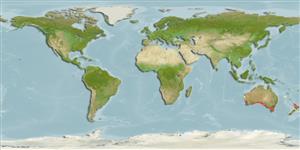Environment: milieu / climate zone / depth range / distribution range
Écologie
marin démersal; profondeur ? - 100 m (Ref. 9563). Temperate
Eastern Indian Ocean: southern Australia, from Western Australia to New South Wales and Tasmania.
Taille / Poids / Âge
Maturity: Lm ? range ? - ? cm
Max length : 30.0 cm TL mâle / non sexé; (Ref. 9563)
Épines dorsales (Total): 4; Rayons mous dorsaux (Total): 8; Rayons mous anaux: 7. Dorsal sides of head and body light brown, ventral side white. Males with many small black blotches on head, body, and fins; females without black blotches. Caudal fin elongate, in males with 4 to 6 medial filaments; in females convex, without filaments. Preopercular spine with a dorsal point additionally to main tip, but without an antrorse spine at its base. First dorsal fin not much higher than second dorsal fin. Caudal fin in males with 5 or 6 median filaments (Ref 42832).
The name 'stinkfish' refers to the acid smell of the slime covering the body; the slime tastes bitter and may be toxic; only some birds of prey take this species (Ref. 557).
Life cycle and mating behavior
Maturité | Reproduction | Frai | Œufs | Fécondité | Larves
Paulin, C., A. Stewart, C. Roberts and P. McMillan, 1989. New Zealand fish: a complete guide. National Museum of New Zealand Miscellaneous Series No. 19. 279 p. (Ref. 5755)
Statut dans la liste rouge de l'IUCN (Ref. 130435)
Menace pour l'homme
Harmless
Utilisations par l'homme
Plus d'informations
Noms communsSynonymesMétabolismePrédateursÉcotoxicologieReproductionMaturitéFraiRassemblement de ponteFéconditéŒufsDéveloppement de l'œuf
RéférencesAquacultureProfil d'aquacultureSouchesGénétiqueElectrophoresesHéritabilitéPathologiesTraitementNutrientsMass conversion
CollaborateursImagesStamps, Coins Misc.SonsCiguateraVitesseType de nageSurface branchialeOtolithesCerveauxVision
Outils
Articles particuliers
Télécharger en XML
Sources Internet
Estimates based on models
Preferred temperature (Ref.
123201): 14.1 - 17.9, mean 14.8 °C (based on 52 cells).
Phylogenetic diversity index (Ref.
82804): PD
50 = 0.5020 [Uniqueness, from 0.5 = low to 2.0 = high].
Bayesian length-weight: a=0.01148 (0.00455 - 0.02896), b=2.92 (2.70 - 3.14), in cm total length, based on LWR estimates for this (Sub)family-body shape (Ref.
93245).
Niveau trophique (Ref.
69278): 3.4 ±0.4 se; based on size and trophs of closest relatives
Résilience (Ref.
120179): Milieu, temps minimum de doublement de population : 1,4 à 4,4 années (Preliminary K or Fecundity.).
Fishing Vulnerability (Ref.
59153): Low vulnerability (20 of 100).
Nutrients (Ref.
124155): Calcium = 49.5 [31.9, 93.9] mg/100g; Iron = 0.401 [0.262, 0.665] mg/100g; Protein = 18.4 [17.6, 19.2] %; Omega3 = 0.63 [0.39, 1.03] g/100g; Selenium = 12 [7, 22] μg/100g; VitaminA = 15.8 [5.0, 47.8] μg/100g; Zinc = 0.661 [0.492, 0.908] mg/100g (wet weight);
